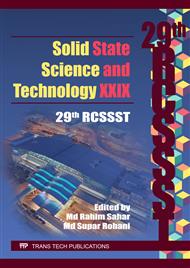[1]
N. S. Baik, G. Sakai, N. Miura, and N. Yamazoe, Hydrothermally treated sol solution of tin oxide for thin-film gas sensor, Sensors Actuators, B Chem., vol. 63, no. 1, p.74–79, (2000).
DOI: 10.1016/s0925-4005(99)00513-4
Google Scholar
[2]
A. Azam, A. S. Ahmed, S. S. Habib, and A. H. Naqvi, Effect of Mn doping on the structural and optical properties of SnO2 nanoparticles, Journal of Alloys and Compounds, vol. 523, p.83–87, (2012).
DOI: 10.1016/j.jallcom.2012.01.072
Google Scholar
[3]
N. D. Md Sin, S. A. Kamaruddin, M. Z. Musa, and M. Rusop, Effect of Deposition Time SnO2 Thin Film Deposited using Thermal CVD for Humidity Sensor Application, p.459–462, (2011).
DOI: 10.1109/isiea.2011.6108752
Google Scholar
[4]
S. Das and V. Jayaraman, SnO2: A comprehensive review on structures and gas sensors, Prog. Mater. Sci., vol. 66, p.112–255, (2014).
DOI: 10.1016/j.pmatsci.2014.10.001
Google Scholar
[5]
G. Zhang and M. Liu, Effect of particle size and dopant on properties of SnO 2 -based gas sensors, p.144–152, (2000).
Google Scholar
[6]
M. M. Rahman, A. Jamal, S. B. Khan, and M. Faisal, Highly sensitive ethanol chemical sensor based on Ni-doped SnO2 nanostructure materials, Biosens. Bioelectron., vol. 28, no. 1, p.127–134, (2011).
DOI: 10.1016/j.bios.2011.07.024
Google Scholar
[7]
L. S. Chuah, M. S. Yaacob, Z. Hassan, and P. Section, Low temperature synthesis of Ni-doped SnO2 thin films by spin coating route, vol. 6, no. 1, p.149–153, (2012).
Google Scholar
[8]
N. D. Md Sin, M. H. Mamat, M. Z. Musa, A. Aziz, and M. Rusop, Effect of Growth Duration to the Electrical Properties of Zn Doped SnO2 Thin Film toward Humidity Sensor Application, (2012).
DOI: 10.1109/beiac.2012.6226112
Google Scholar
[9]
M. Batzill and U. Diebold, The surface and materials science of tin oxide, Prog. Surf. Sci., vol. 79, no. 2–4, p.47–154, (2005).
DOI: 10.1016/j.progsurf.2005.09.002
Google Scholar
[10]
M. M. Arafat, B. Dinan, S. A. Akbar, and A. S. M. A. Haseeb, Gas sensors based on one dimensional nanostructured metal-oxides: A review, Sensors (Switzerland), vol. 12, no. 6, p.7207–7258, (2012).
DOI: 10.3390/s120607207
Google Scholar
[11]
M. Awalludin, M. H. Mamat, M. Z. Sahdan, Z. Mohamad, and M. Rusop, Zinc Oxide Nanorods Characteristics Prepared by Sol-Gel Immersion Method Immersed at Different Times, Adv. Mater. Res., vol. 667, p.375–379, (2013).
DOI: 10.4028/www.scientific.net/amr.667.375
Google Scholar
[12]
S. Shukla, S. Patil, S. C. Kuiry, Z. Rahman, T. Du, L. Ludwig, C. Parish, and S. Seal, Synthesis and characterization of sol-gel derived nanocrystalline tin oxide thin film as hydrogen sensor, Sensors Actuators, B Chem., vol. 96, no. 1–2, p.343–353, (2003).
DOI: 10.1016/s0925-4005(03)00568-9
Google Scholar
[13]
H. S. Nalwa, Handbook of Thin Films. Elsevier, (2002).
Google Scholar
[14]
D. Yang, Nanocomposite Films for Gas Sensing, Adv. Nanocomposites - Synth. Charact. Ind. Appl., p.857–882, (2011).
Google Scholar
[15]
E. Heredia, C. Bojorge, J. Casanova, H. Cánepa, A. Craievich, and G. Kellermann, Nanostructured ZnO thin films prepared by sol–gel spin-coating, Appl. Surf. Sci., vol. 317, p.19–25, Oct. (2014).
DOI: 10.1016/j.apsusc.2014.08.046
Google Scholar
[16]
N. D. Md Sin, M. F. Tahar, M. H. Mamat, and M. Rusop, Recent Trends in Nanotechnology and Materials Science, (2014).
Google Scholar
[17]
S. G. Ansari, P. Boroojerdian, S. R. Sainkar, R. N. Karekar, R. C. Aiyer, and S. K. Kulkarni, Grain size effects on H2 gas sensitivity of thick film resistor using SnO2 nanoparticles, Thin Solid Films, vol. 295, no. 1–2, p.271–276, (1997).
DOI: 10.1016/s0040-6090(96)09152-3
Google Scholar
[18]
A. Johari, M. C. Bhatnagar, and V. Rana, Growth, Characterization and I-V Characteristics of Tin Oxide (SnO2) nanowires, vol. 3, no. 6, pp.515-518, (2012).
DOI: 10.5185/amlett.2012.icnano.251
Google Scholar


